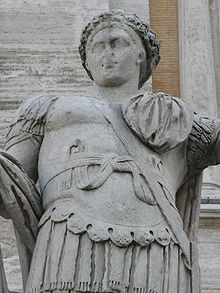Constantine II (emperor)
From Wikipedia, the free encyclopedia
| Constantine II | |
|---|---|
| Emperor of the Roman Empire | |
 | |
| Porphyry statue of Constantine II | |
| Reign | 1 March 317 – 337 (as Caesar in the west under his father); 337 – 340 (joint emperor with Constantius II and Constans, over Gaul, Hispania, and Britannia, in 340 in failed competition with Constans); |
| Full name | Flavius Claudius Constantinus |
| Born | February, 317 |
| Birthplace | Arelate, Viennensis |
| Died | 340 |
| Place of death | Aquileia, Italia |
| Predecessor | Constantine I |
| Successor | Constantius II and Constans |
| Dynasty | Constantinian |
| Father | Constantine the Great |
[edit] Career

Statue of emperor Constantine II as caesar on top of the Cordonata (the monumental ladder climbing up to Piazza del Campidoglio), in Rome.
Following the death of his father in 337, Constantine II initially became emperor jointly with his brothers Constantius II and Constans,[7] with the empire divided between them and their cousins, the Caesars Dalmatius and Hannibalianus.[8] This arrangement barely survived Constantine I’s death, with the sons of Constantine arranging the slaughter of most of the family of Constantine I at the hands of the army.[9] As a result, the three brothers gathered together in Pannonia[5] and there on September 9, 337,[1][9] divided the Roman world between themselves. Constantine, proclaimed Augustus by the troops[1] received Gaul, Britannia and Hispania.[6]

Division of the Roman Empire among the Caesars appointed by Constantine I: from left to right, the territories of Constantine II, Constans I, Dalmatius and Constantius II. After the death of Constantine I (May 337), this was the formal division of the Empire, until Dalmatius was killed and his territory divided between Constans and Constantius.
At first, he was the guardian of his younger brother Constans, whose portion was Italia, Africa and Illyricum. Constantine soon complained that he had not received the amount of territory that was his due, stemming from his position as the eldest of Constantine’s sons.[9] Annoyed that Constans had received Thrace and Macedonia after the death of Dalmatius, Constantine demanded that Constans hand over the African provinces, which, in order to maintain a fragile peace, he agreed to do.[9][11] Soon however, they began quarrelling over which parts of the African provinces belonged to Carthage, and thus Constantine, and that which belonged to Italy, and therefore Constans.[12]
Additional complications also arose when Constans came of age, and Constantine, who had grown used to dominating his younger brother, would not relinquish the guardianship. Therefore in 340 he marched into Italy at the head of his troops.[11] Constans, at that time in Dacia, detached and sent a select and disciplined body of his Illyrian troops, stating that he would follow them in person with the remainder of his forces.[9] Constantine was engaged in military operations around Aquileia[7] and he was killed in an ambush in Cervignano del Friuli.[11] Constans took control of his deceased brother's realm.

Tidak ada komentar:
Posting Komentar